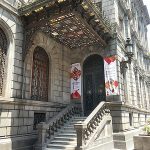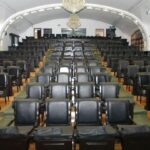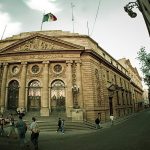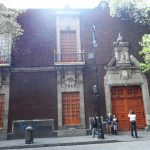



History and comeback of the Fru Fru Theater
The “Fru Fru” theater is a building with more than a century of history, located at Donceles number 24, in the Historic Center of Mexico City. It was inaugurated in 1899 under the name of “Teatro Renacimiento”, with the presentation of the opera Aida. Since then it consolidated as one of the most important venues in the capital and stood out for being the first to have electricity inside. In 1906, Francisco Cardona, actor and businessman, acquired the venue and changed its name to Virginia Fábregas, in honor of the iconic Mexican actress and businesswoman.
Inside, ornamental elements make this stage a great attraction: red velvet, golden sculptures, crystal chandeliers and the ironwork of its doors, inspired by the French style, integrates details that give it a unique style.
It was the scene of great shows and artistic expressions where the most renowned night dancers, who used to wear tiny dresses accompanied by large feathered headdresses.
With the arrival of the cinema, the theater was forced to close its doors and there were even rumors about its demolition; however, in 1973 it was acquired by the actress and singer Irma Serrano, known as “La Tigresa”, who promoted a new stage for the newly named “Teatro Fru Fru”, modernizing the billboard with productions that were a great success. However, the themes they addressed were controversial for the time and generated strong criticism, as they dealt with issues considered “taboo”.
From the 1980s onwards, the theater reduced its cultural offerings and became a stage for concerts, music videos and movies. It has received audiovisual productions such as James Bond and Cantinflas; the recording of music videos of national and international artists.
The building offers tourist tours and is undoubtedly a venue of great value that holds in its interior a fundamental part of the history and evolution of theater and entertainment in Mexico City.
Did you know that the name “Fru Fru” is the onomatopoeia related to the sound that silk makes when rubbed?
It is said that, when visiting the theater, you should bring an offering to the golden sculptures that decorate the venue to avoid witnessing paranormal experiences or falls.
 albertorico_teatrofrufru@hotmail.com
albertorico_teatrofrufru@hotmail.com
 (55) 4202 3788
(55) 4202 3788
 https://www.facebook.com/pages/Teatro-Fru-Fru/215265188488364
https://www.facebook.com/pages/Teatro-Fru-Fru/215265188488364

Nearest at 0.04 kms.

Nearest at 0.04 kms.

Nearest at 0.04 kms.

A modern graphic collection in an outstanding Baroque palace from the 18th century.

Mexico's National College is dedicated to the free sharing of knowledge and learning.

Quite likely the most important theater and performance space in all of Mexico City, of course it's the Esperanza Iris.

A Donceles palace is home to Mexico City's Legislative Assembly, a storied Neoclassical complex.

Among the most noteworthy of architectural sites on the Calle Donceles, much better known for its used booksellers.